Spatial and Temporal Variation of Aerosol and Water Vapour Effects on Solar Radiation in the Mediterranean Basin during the Last Two Decades
Abstract
1. Introduction
2. Dataset and Methodology
3. Results
3.1. Spatial Distribution
3.2. Temporal Distribution
4. Conclusions
Author Contributions
Funding
Acknowledgments
Conflicts of Interest
References
- Sanchez-Lorenzo, A.; Calbó, J.; Brunetti, M.; Deser, C. Dimming/brightening over the Iberian Peninsula: Trends in sunshine duration and cloud cover and their relations with atmospheric circulation. J. Geophys. Res. Space Phys. 2009, 114, D00D09. [Google Scholar] [CrossRef]
- Wild, M.; Folini, D.; Schär, C.; Loeb, N.; Dutton, E.G.; König-Langlo, G. The global energy balance from a surface perspective. Clim. Dyn. 2012, 40, 3107–3134. [Google Scholar] [CrossRef]
- Wild, M.; Liepert, B. The Earth radiation balance as driver of the global hydrological cycle. Environ. Res. Lett. 2010, 5, 025203. [Google Scholar] [CrossRef]
- Giorgi, F. Climate change hot-spots. Geophys. Res. Lett. 2006, 33. [Google Scholar] [CrossRef]
- Papadimas, C.D.; Hatzianastassiou, N.; Mihalopoulos, N.; Querol, X.; Vardavas, I. Spatial and temporal variability in aerosol properties over the Mediterranean basin based on 6-year (2000–2006) MODIS data. J. Geophys. Res. Space Phys. 2008, 113. [Google Scholar] [CrossRef]
- Lelieveld, J.; Berresheim, H.; Borrmann, S.; Crutzen, P.; Dentener, F.; Fischer, H.; Feichter, J.; Flatau, P.J.; Heland, J.; Holzinger, R.; et al. Global Air Pollution Crossroads over the Mediterranean. Science 2002, 298, 794–799. [Google Scholar] [CrossRef]
- Formenti, P.; Andreae, M.O.; Andreae, T.W.; Galani, E.; Vasaras, A.; Zerefos, C.; Amiridis, V.; Orlovsky, L.; Karnieli, A.; Wendisch, M.; et al. Aerosol optical properties and large-scale transport of air masses: Observations at a coastal and a semiarid site in the eastern Mediterranean during summer 1998. J. Geophys. Res. Space Phys. 2001, 106, 9807–9826. [Google Scholar] [CrossRef]
- Andreae, M.O.; Ichoku, C.; Cafmeyer, J.; Maenhaut, W.; Karnieli, A.; Orlovsky, L. Light scattering by dust and anthropogenic aerosol at a remote site in the Negev desert, Israel. J. Geophys. Res. Space Phys. 2002, 107, 107. [Google Scholar] [CrossRef]
- Costa, M.J.; Sohn, B.-J.; Levizzani, V.; Silva, A.M. Radiative Forcing of Asian Dust Determined from the Synergized GOME and GMS Satellite Data—A Case Study. J. Meteorol. Soc. Jpn. 2006, 84, 85–95. [Google Scholar] [CrossRef]
- Di Sarra, A.; Pace, G.; Meloni, D.; De Silvestri, L.; Piacentino, S.; Monteleone, F. Surface shortwave radiative forcing of different aerosol types in the central Mediterranean. Geophys. Res. Lett. 2008, 35, 02714. [Google Scholar] [CrossRef]
- Santos, D.; Costa, M.J.; Silva, A.M. Direct SW aerosol radiative forcing over Portugal. Atmos. Chem. Phys. Discuss. 2008, 8, 5771–5786. [Google Scholar] [CrossRef]
- Esteve, A.; Estelles, V.; Utrillas, M.P.; Martinez-Lozano, J.A. Analysis of the aerosol radiative forcing over a Mediterranean urban coastal site. Atmos. Res. 2014, 137, 195–204. [Google Scholar] [CrossRef]
- Mateos, D.; Anton, M.; Toledano, C.; Cachorro, V.E.; Alados-Arboledas, L.; Sorribas, M.; Costa, M.J.; Baldasano, J.M. Aerosol radiative effects in the ultraviolet, visible, and near-infrared spectral ranges using long-term aerosol data series over the Iberian Peninsula. Atmos. Chem. Phys. Discuss. 2014, 14, 13497–13514. [Google Scholar] [CrossRef]
- Obregón, M.A.; Pereira, S.N.; Salgueiro, V.; Costa, M.J.; Silva, A.M.; Serrano, A.; Bortoli, D. Aerosol radiative effects during two desert dust events in August 2012 over the Southwestern Iberian Peninsula. Atmos. Res. 2015, 153, 404–415. [Google Scholar] [CrossRef]
- Obregón, M.A.; Costa, M.J.; Serrano, A.; Silva, A.M. Effect of water vapor in the SW and LW downward irradiance at the surface during a day with low aerosol load. IOP Conf. Series: Earth Environ. Sci. 2015, 28, 12009. [Google Scholar] [CrossRef]
- Floutsi, A.A.; Korras-Carraca, M.B.; Matsoukas, C.; Hatzianastassiou, N.; Biskos, G. Climatology and trends of aerosol optical depth over the Mediterranean basin during the last 12 years (2002–2014) based on Collection 006 MODIS-Aqua data. Sci. Total Environ. 2016, 551–552, 292–303. [Google Scholar] [CrossRef]
- Obregón, M.A.; Costa, M.J.; Silva, A.M.; Serrano, A. Thirteen Years of Aerosol Radiative Forcing in Southwestern Iberian Peninsula. Aerosol Air Qual. Res. 2017, 17, 2509–2521. [Google Scholar] [CrossRef]
- Vaquero-Martínez, J.; Antón, M.; Ortiz-De-Galisteo, J.P.; Román, R.; Cachorro, V. Water vapor radiative effects on short-wave radiation in Spain. Atmos. Res. 2018, 205, 18–25. [Google Scholar] [CrossRef]
- Trenberth, K.E.; Fasullo, J.T.; Smith, L. Trends and variability in column-integrated atmospheric water vapor. Clim. Dyn. 2005, 24, 741–758. [Google Scholar] [CrossRef]
- Mattar, C.; Sobrino, J.A.; Julien, Y.; Morales, L. Trends in column integrated water vapour over Europe from 1973 to 2003. Int. J. Clim. 2010, 31, 1749–1757. [Google Scholar] [CrossRef]
- Sorribas, M.; Andrews, E.; Ogren, J.; Del Águila, A.; Fraile, R.; Sheridan, P.; Yela, M. Climatological study for understanding the aerosol radiative effects at southwest Atlantic coast of Europe. Atmos. Environ. 2019, 205, 52–66. [Google Scholar] [CrossRef]
- Mateos, D.; Antón, M.; Sanchez-Lorenzo, A.; Calbó, J.; Wild, M. Long-term changes in the radiative effects of aerosols and clouds in a mid-latitude region (1985–2010). Glob. Planet. Chang. 2013, 111, 288–295. [Google Scholar] [CrossRef]
- Obregón, M.A.; Costa, M.J.; Silva, A.; Serrano, A. Impact of aerosol and water vapour on SW radiation at the surface: Sensitivity study and applications. Atmos. Res. 2018, 213, 252–263. [Google Scholar] [CrossRef]
- Nabat, P.; Somot, S.; Mallet, M.; Chiapello, I.; Morcrette, J.J.; Solmon, F.; Szopa, S.; Dulac, F.; Collins, W.; Ghan, S.; et al. A 4-D climatology (1979–2009) of the monthly tropospheric aerosol optical depth distribution over the Mediterranean region from a comparative evaluation and blending of remote sensing and model products. Atmos. Meas. Tech. 2013, 6, 1287–1314. [Google Scholar] [CrossRef]
- Alexandri, G.; Georgoulias, A.; Meleti, C.; Balis, D.; Kourtidis, K.; Sanchez-Lorenzo, A.; Trentmann, J.; Zanis, P. A high resolution satellite view of surface solar radiation over the climatically sensitive region of Eastern Mediterranean. Atmos. Res. 2017, 188, 107–121. [Google Scholar] [CrossRef]
- Provençal, S.; Kishcha, P.; Da Silva, A.M.; Elhacham, E.; Alpert, P. AOD distributions and trends of major aerosol species over a selection of the world’s most populated cities based on the 1st version of NASA’s MERRA Aerosol Reanalysis. Urban Clim. 2017, 20, 168–191. [Google Scholar] [CrossRef]
- Ho, S.-P.; Peng, L.; Mears, C.; Anthes, R.A. Comparison of global observations and trends of total precipitable water derived from microwave radiometers and COSMIC radio occultation from 2006 to 2013. Atmos. Chem. Phys. Discuss. 2018, 18, 259–274. [Google Scholar] [CrossRef]
- Bilbao, J.; Román, R.; Yousif, C.; Mateos, D.; De Miguel, A. Total ozone column, water vapour and aerosol effects on erythemal and global solar irradiance in Marsaxlokk, Malta. Atmos. Environ. 2014, 99, 508–518. [Google Scholar] [CrossRef]
- Goto, D.; Schutgens, N.A.J.; Nakajima, T.; Takemura, T. Sensitivity of aerosol to assumed optical properties over Asia using a global aerosol model and AERONET. Geophys. Res. Lett. 2011, 38, 17810. [Google Scholar] [CrossRef]
- Wielicki, B.A.; Barkstrom, B.R.; Harrison, E.F.; Lee, R.B.; Smith, G.L.; Cooper, J.E. Clouds and the Earth’s Radiant Energy System (CERES): An Earth Observing System Experiment. Bull. Am. Meteorol. Soc. 1996, 77, 853–868. [Google Scholar] [CrossRef]
- Doelling, D.; Loeb, N.G.; Keyes, D.F.; Nordeen, M.L.; Morstad, D.; Nguyen, C.; Wielicki, B.; Young, D.F.; Sun, M. Geostationary Enhanced Temporal Interpolation for CERES Flux Products. J. Atmos. Ocean. Technol. 2013, 30, 1072–1090. [Google Scholar] [CrossRef]
- Rutan, D.A.; Kato, S.; Doelling, D.; Rose, F.G.; Nguyen, L.T.; Caldwell, T.E.; Loeb, N.G. CERES Synoptic Product: Methodology and Validation of Surface Radiant Flux. J. Atmos. Ocean. Technol. 2015, 32, 1121–1143. [Google Scholar] [CrossRef]
- Remer, L.A.; Kaufman, Y.J.; Tanré, D.; Mattoo, S.; Chu, D.A.; Martins, J.V.; Li, R.-R.; Ichoku, C.; Levy, R.C.; Kleidman, R.G.; et al. The MODIS Aerosol Algorithm, Products and Validation. J. Atmos. Sci 2003, 62, 947–973. [Google Scholar] [CrossRef]
- Collins, W.; Rasch, P.J.; Eaton, B.E.; Khattatov, B.V.; Lamarque, J.-F.; Zender, C. Simulating aerosols using a chemical transport model with assimilation of satellite aerosol retrievals: Methodology for INDOEX. J. Geophys. Res. Space Phys. 2001, 106, 7313–7336. [Google Scholar] [CrossRef]
- Gao, B.-C.; Kaufman, Y.J. Water vapor retrievals using Moderate Resolution Imaging Spectroradiometer (MODIS) near-infrared channels. J. Geophys. Res. Space Phys. 2003, 108, 4389. [Google Scholar] [CrossRef]
- Sayer, A.M.; Hsu, N.C.; Bettenhausen, C.; Jeong, M.-J. Validation and uncertainty estimates for MODIS Collection 6 “Deep Blue” aerosol data. J. Geophys. Res. Atmos. 2013, 118, 7864–7872. [Google Scholar] [CrossRef]
- Chu, D.A.; Kaufman, Y.J.; Ichoku, C.; Remer, L.A.; Tanré, D.; Holben, B.N. Validation of MODIS aerosol optical depth retrieval over land. Geophys. Res. Lett. 2002, 29, 1617. [Google Scholar] [CrossRef]
- Mishra, A.K.; Rudich, Y.; Koren, I. Spatial boundaries of Aerosol Robotic Network observations over the Mediterranean basin. Geophys. Res. Lett. 2016, 43, 2259–2266. [Google Scholar] [CrossRef]
- Prasad, A.; Singh, R.P. Validation of MODIS Terra, AIRS, NCEP/DOE AMIP-II Reanalysis-2, and AERONET Sun photometer derived integrated precipitable water vapor using ground-based GPS receivers over India. J. Geophys. Res. Space Phys. 2009, 114. [Google Scholar] [CrossRef]
- Sen, P.K. Estimates of the regression coefficient based on Kendall’s tau. J. Amer. Stat. Assoc. 1968, 63, 1379–1389. [Google Scholar] [CrossRef]
- Estelles, V.; Martinez-Lozano, J.A.; Utrillas, M.P. Influence of air mass history on the columnar aerosol properties at Valencia, Spain. J. Geophys. Res. Space Phys. 2007, 112, 112. [Google Scholar] [CrossRef]
- Lyamani, H.; Olmo, F.; Alados-Arboledas, L. Physical and optical properties of aerosols over an urban location in Spain: Seasonal and diurnal variability. Atmos. Chem. Phys. Discuss. 2010, 10, 239–254. [Google Scholar] [CrossRef]
- Pereira, S.N.; Wagner, F.; Silva, A.M. Seven years of measurements of aerosol scattering properties, near the surface, in the southwestern Iberia Peninsula. Atmos. Chem. Phys. Discuss. 2011, 11, 17–29. [Google Scholar] [CrossRef]
- Obregón, M.A.; Pereira, S.N.; Wagner, F.; Serrano, A.; Cancillo, M.L.; Silva, A.M. Regional differences of column aerosol parameters in western Iberian Peninsula. Atmos. Environ. 2012, 62, 208–219. [Google Scholar] [CrossRef]
- Evgenieva, T.T.; Wiman, B.L.B.; Kolev, N.I.; Savov, P.B.; Donev, E.H.; Ivanov, D.I.; Danchovski, V.; Kaprielov, B.K.; Grigorieva, V.N.; Iliev, I.; et al. Three-point observation in the troposphere over Sofia-Plana Mountain, Bulgaria. Int. J. Remote Sens. 2011, 32, 9343–9363. [Google Scholar] [CrossRef]
- Papadimas, C.D.; Hatzianastassiou, N.; Matsoukas, C.; Kanakidou, M.; Mihalopoulos, N.; Vardavas, I. The direct effect of aerosols on solar radiation over the broader Mediterranean basin. Atmos. Chem. Phys. Discuss. 2012, 12, 7165–7185. [Google Scholar] [CrossRef]
- Schepanski, K.; Tegen, I.; Todd, M.C.; Heinold, B.; Bonisch, G.; Laurent, B.; Macke, A. Meteorological processes forcing Saharan dust emission inferred from MSG-SEVIRI observations of subdaily dust source activation and numerical models. J. Geophys. Res. Space Phys. 2009, 114. [Google Scholar] [CrossRef]
- Malico, I.; Pereira, S.N.; Costa, M.J. Black carbon trends in southwestern Iberia in the context of the financial and economic crisis. The role of bioenergy. Environ. Sci. Pollut. Res. 2016, 24, 476–488. [Google Scholar] [CrossRef]
- Chiapello, I.; Bergametti, G.; Gomes, L.; Chatenet, B.; Dulac, F.; Pimenta, J.; Suares, E.S. An additional low layer transport of Sahelian and Saharan dust over the north-eastern Tropical Atlantic. Geophys. Res. Lett. 1995, 22, 3191–3194. [Google Scholar] [CrossRef]
- Díaz, A.M.; Díaz, J.P.; Exposito, F.J.; Hernández-Leal, P.A.; Savoie, D.; Querol, X. Air masses and aerosols chemical components in the free troposphere at the subtropical northeast atlantic region. J. Atmos. Chem. 2006, 53, 63–90. [Google Scholar] [CrossRef]
- Palau, J.L.; Rovira, F.; Sales, M.J. Satellite Observations of the Seasonal Evolution of Total Precipitable Water Vapour over the Mediterranean Sea. Adv. Meteorol. 2017, 2017, 1–9. [Google Scholar] [CrossRef]
- Millán, M.M.; Mantilla, E.; Salvador, R.; Kallos, G. Photooxidant dynamics in the Mediterranean basin in summer: Results from European research projects. J. Geophys. Res. Space Phys. 1997, 102, 8811–8823. [Google Scholar] [CrossRef]
- Levy, I.; Dayan, U.; Mahrer, Y. A five-year study of coastal recirculation and its effect on air pollutants over the East Mediterranean region. J. Geophys. Res. Space Phys. 2008, 113, 113. [Google Scholar] [CrossRef]
- Kallos, G.; Mitsakou, C.; Alastuey, A. Mechanisms of climate variability, air quality and impacts of atmospheric constituents in the Mediterranean Region. In Regional Assessment Climate Change in the Mediterranean; Navarra, A., Tubiana, L., Eds.; Springer: Berlin, Germany, 2013; Volume 3, pp. 119–156. [Google Scholar]
- Millán, M.M.; Estrela, M.J.; Sanz, M.J.; Mantilla, E.; Martin, M.; Pastor, F.; Salvador, R.; Vallejo, V.R.; Alonso, L.; Gangoiti, G.; et al. Climatic Feedbacks and Desertification: The Mediterranean Model. J. Clim. 2005, 18, 684–701. [Google Scholar] [CrossRef]
- Hoegh-Guldberg, O.; Jacob, D.; Taylor, M.; Bindi, M.; Brown, S.; Camilloni, I.; Diedhiou, A.; Djalante, R.; Ebi, K.L.; Engelbrecht, F.; et al. Impacts of 1.5 °C Global Warming on Natural and Human Systems. In Global Warming of 1.5 °C. An IPCC Special Report on the Impacts of Global Warming of 1.5 °C Above Pre-Industrial Levels and Related Global Greenhouse Gas Emission Pathways, in the Context of Strengthening the Global Response to the Threat of Climate Change, Sustainable Development, and Efforts to Eradicate Poverty; Masson-Delmotte, V., Zhai, P., Pörtner, H.-O., Roberts, D., Skea, J., Shukla, P.R., Pirani, A., Moufouma-Okia, W., Péan, C., Pidcock, R., Eds.; World Meteorological Organization Technical Document; IPCC Secretariat: Geneva, Switzerland, 2018; in press. [Google Scholar]
- Santacatalina, M.; Yubero, E.; Mantilla, E.; Carratalá, A. Relevance of the economic crisis in chemical PM10 changes in a semi-arid industrial environment. Environ. Monit. Assess. 2011, 184, 6827–6844. [Google Scholar] [CrossRef] [PubMed]
- Monteiro, A.; Russo, M.; Gama, C.; Lopes, M.; Borrego, C. How economic crisis influence air quality over Portugal (Lisbon and Porto)? Atmos. Pollut. Res. 2018, 9, 439–445. [Google Scholar] [CrossRef]
- Eurostat, Eurostat Review on National Accounts and Macroeconomic Indicators; 2016; ISSN 2443–7832. Available online: http://ec.europa.eu/eurostat/documents/3217494/7784358/KS-GP-16-002-EN-N.pdf (accessed on 17 April 2020).
- Collins, M.; Knutti, R.; Arblaster, J.; Dufresne, J.L.; Fichefet, T.; Friedlingstein, P.; Gao, X.; Gutowski, W.J.; Johns, T.; Krinner, G.; et al. Long-term Climate Change: Projections, Commitments and Irreversibility. In Climate Change 2013: The Physical Science Basis. Contribution of Working Group I to the Fifth Assessment Report of the Intergovernmental Panel on Climate Change; Stocker, T.F., Qin, D., Plattner, G.-K., Tignor, M., Allen, S.K., Boschung, J., Nauels, A., Xia, Y., Bex, V., Midgley, P.M., Eds.; Cambridge University Press: Cambridge, UK; New York, NY, USA, 2013. [Google Scholar]
- Zhang, J.; Reid, J.S. A decadal regional and global trend analysis of the aerosol optical depth using a data-assimilation grade over-water MODIS and Level 2 MISR aerosol products. Atmos. Chem. Phys. Discuss. 2010, 10, 10949–10963. [Google Scholar] [CrossRef]
- Alfaro-Contreras, R.; Zhang, J.; Reid, J.S.; Christopher, S. A study of 15-year aerosol optical thickness and direct shortwave aerosol radiative effect trends using MODIS, MISR, CALIOP and CERES. Atmos. Chem. Phys. Discuss. 2017, 17, 13849–13868. [Google Scholar] [CrossRef]
- Alam, K.; Trautmann, T.; Blaschke, T.; Subhan, F. Changes in aerosol optical properties due to dust storms in the Middle East and Southwest Asia. Remote. Sens. Environ. 2014, 143, 216–227. [Google Scholar] [CrossRef]
- Shalaby, A.; Rappenglueck, B.; Eltahir, E.A.B. The climatology of dust aerosol over the arabian peninsula. Atmos. Chem. Phys. Discuss. 2015, 15, 1523–1571. [Google Scholar] [CrossRef]
- Gharibzadeh, M.; Alam, K.; Bidokhti, A.A.; Abedini, Y.A.Y.; Masoumi, A. Radiative Effects and Optical Properties of Aerosol during Two Dust Events in 2013 over Zanjan, Iran. Aerosol Air Qual. Res. 2017, 17, 888–898. [Google Scholar] [CrossRef]
- Chen, B.; Liuid, Z. Global water vapor variability and trend from the latest 36 year (1979 to 2014) data of ECMWF and NCEP reanalyses, radiosonde, GPS, and microwave satellite. J. Geophys. Res. Atmos. 2016, 121, 1144–11462. [Google Scholar] [CrossRef]
- Zhang, Y.H.; Xu, J.; Yang, N.; Lan, P. Variability and Trends in Global Precipitable Water Vapor Retrieved from COSMIC Radio Occultation and Radiosonde Observations. Atmosphere 2018, 9, 174. [Google Scholar] [CrossRef]
- Ciardini, V.; Contessa, G.M.; Falsaperla, R.; Gómez-Amo, J.L.; Meloni, D.; Monteleone, F.; Pace, G.; Piacentino, S.; Sferlazzo, D.; Di Sarra, A. Global and Mediterranean climate change: A short summary. Ann. Ist. Super. Sanita 2016, 52, 325–337. [Google Scholar] [PubMed]
- Gurbuz, G.; Jin, S. Long-time variations of precipitable water vapour estimated from GPS, MODIS and radiosonde observations in Turkey. Int. J. Clim. 2017, 37, 5170–5180. [Google Scholar] [CrossRef]
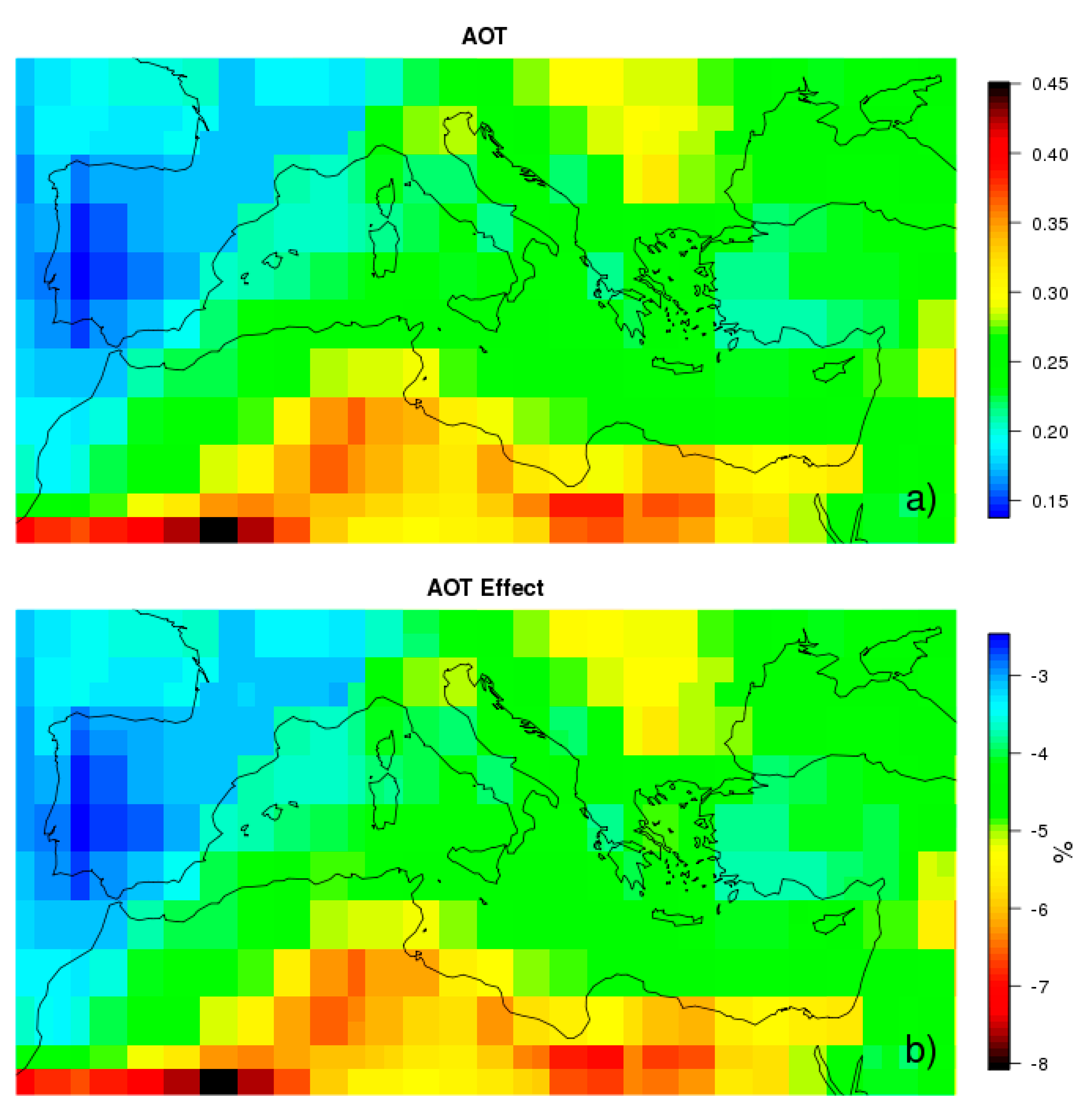
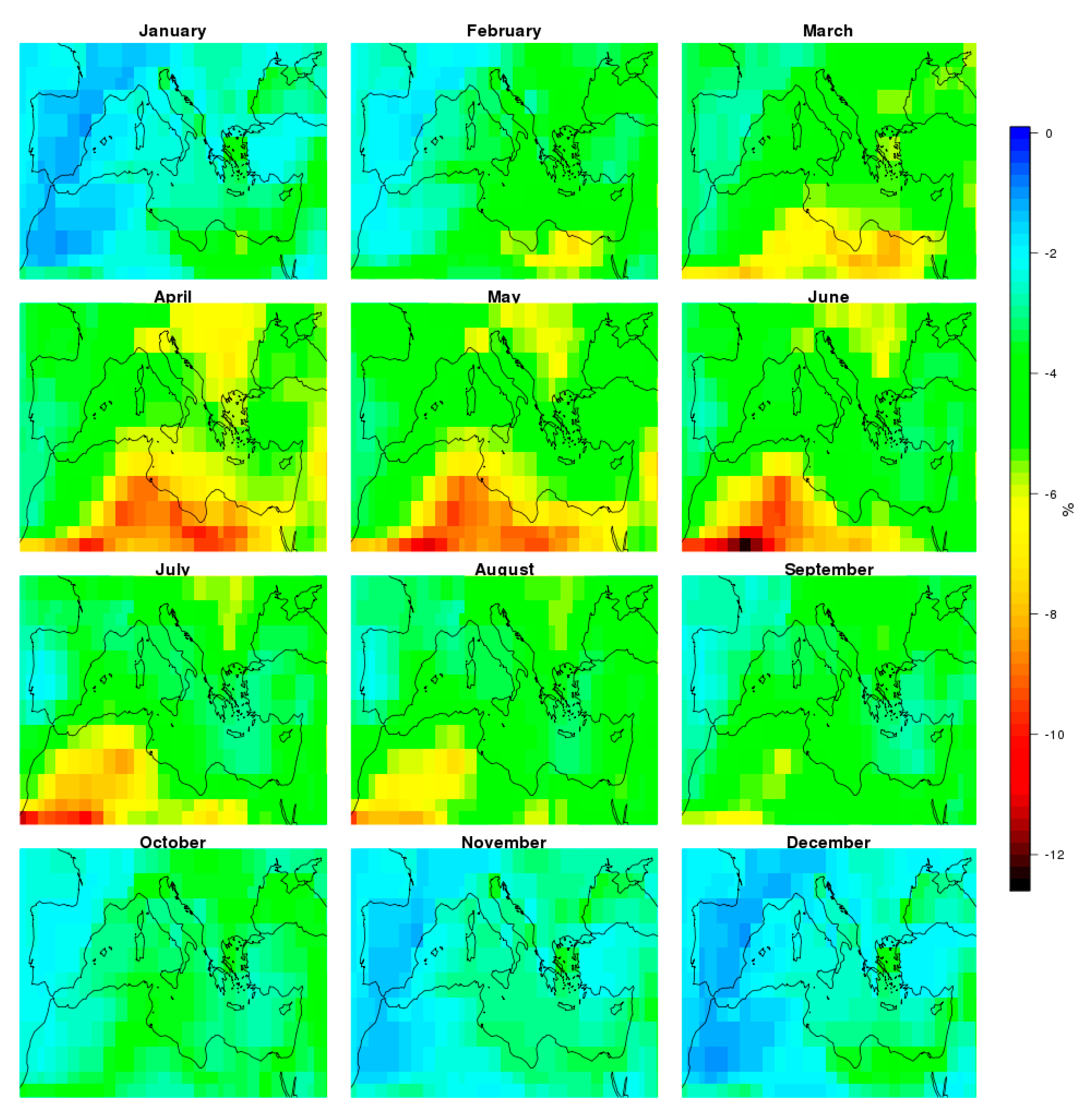
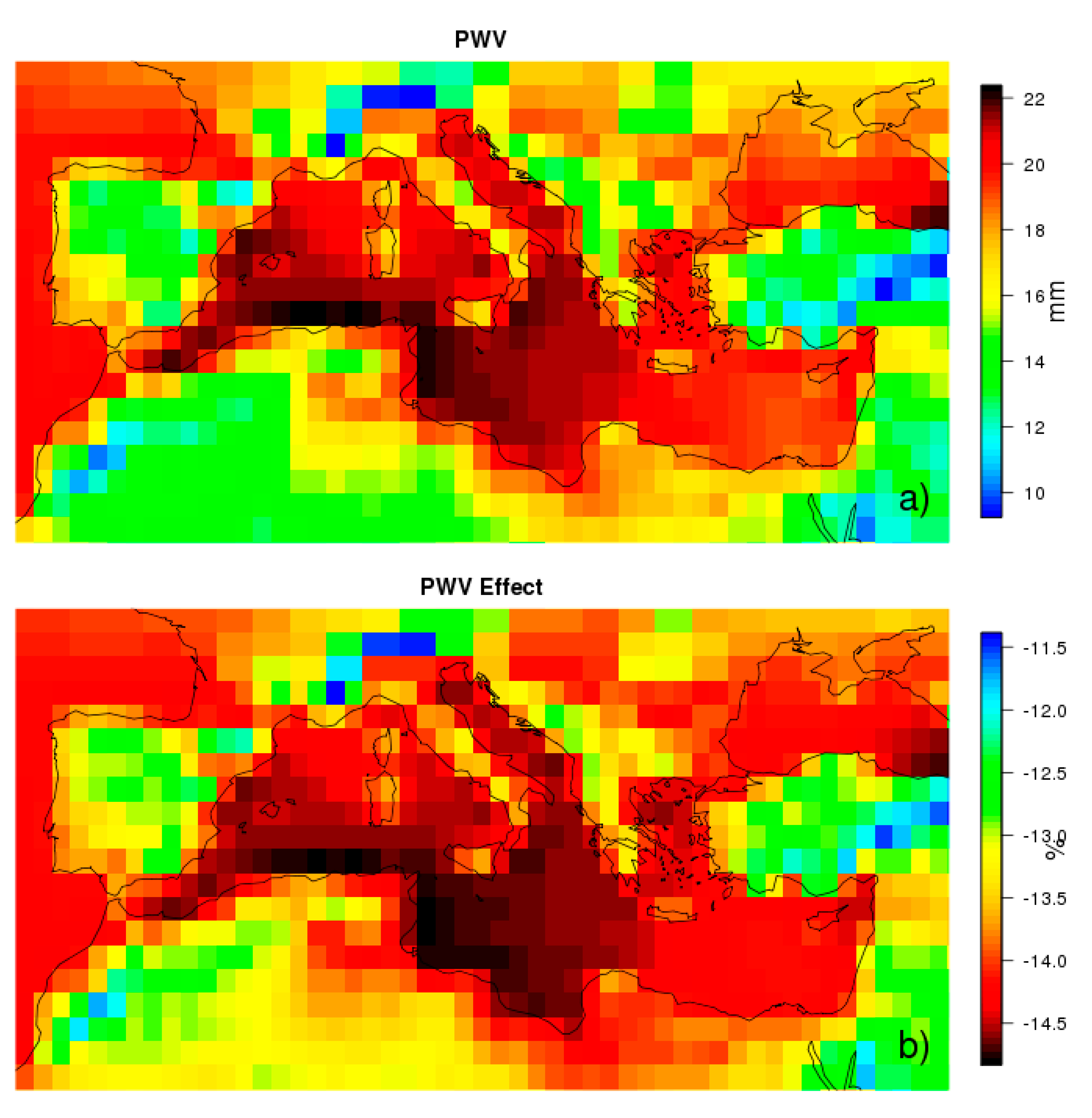
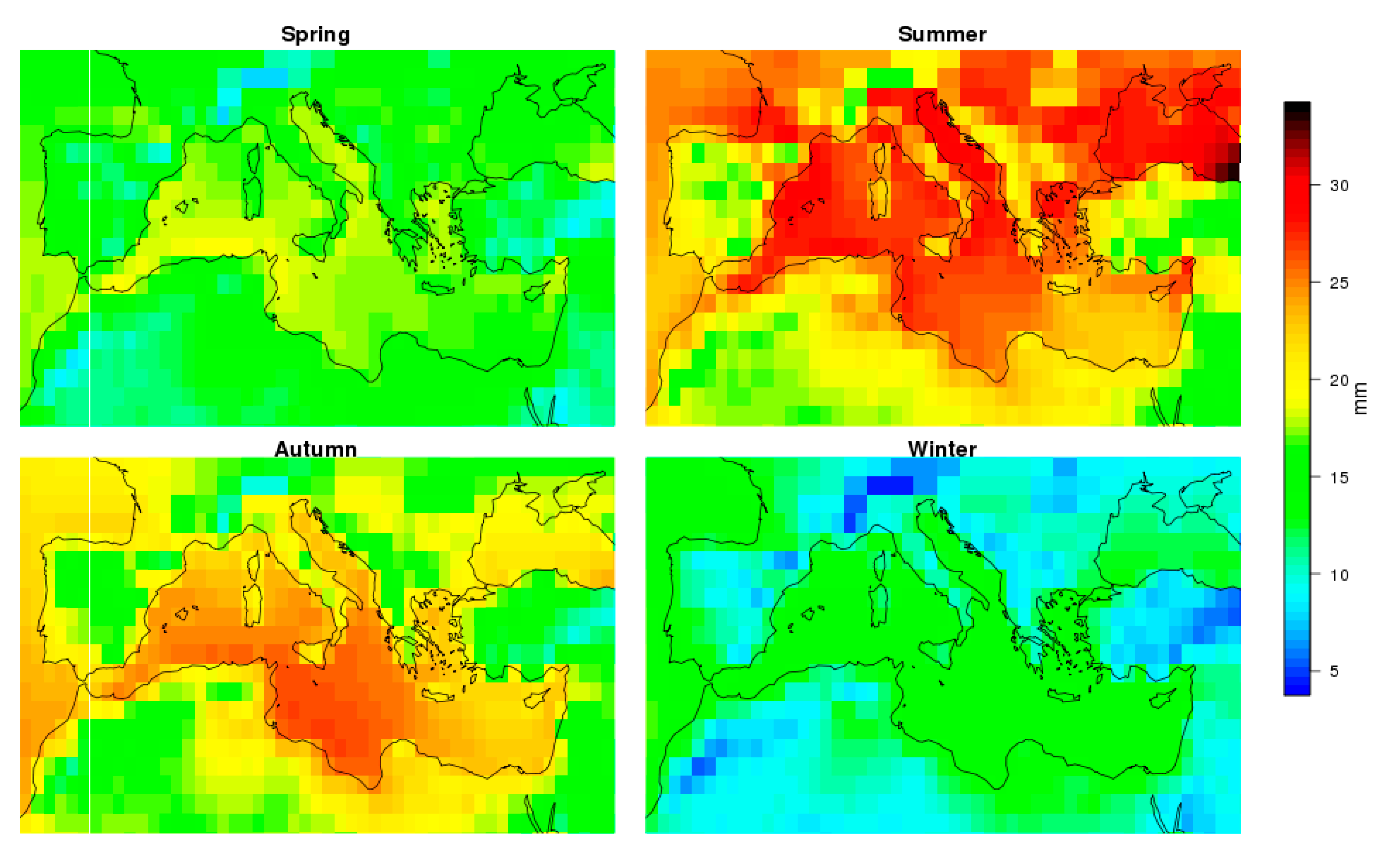
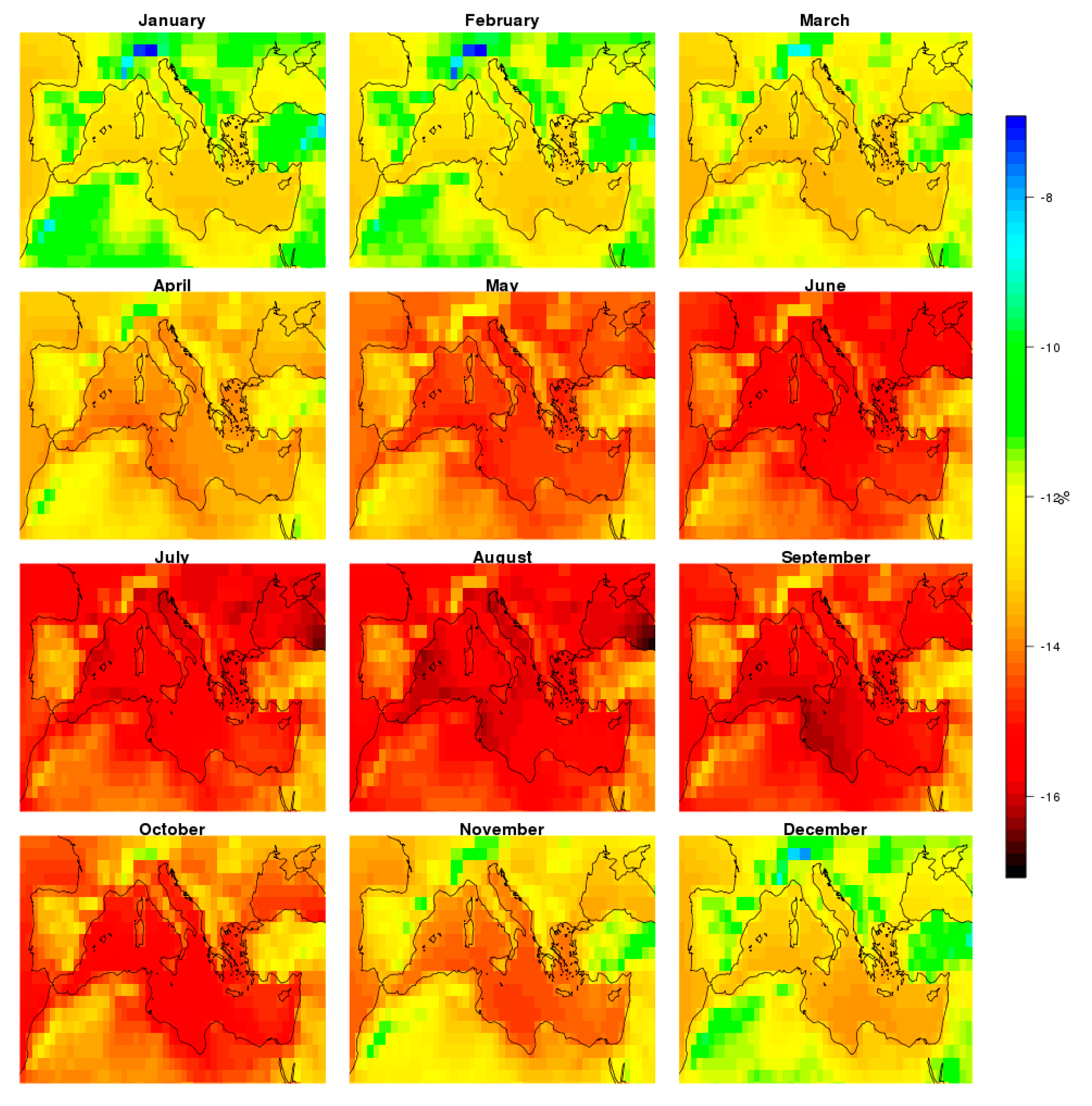

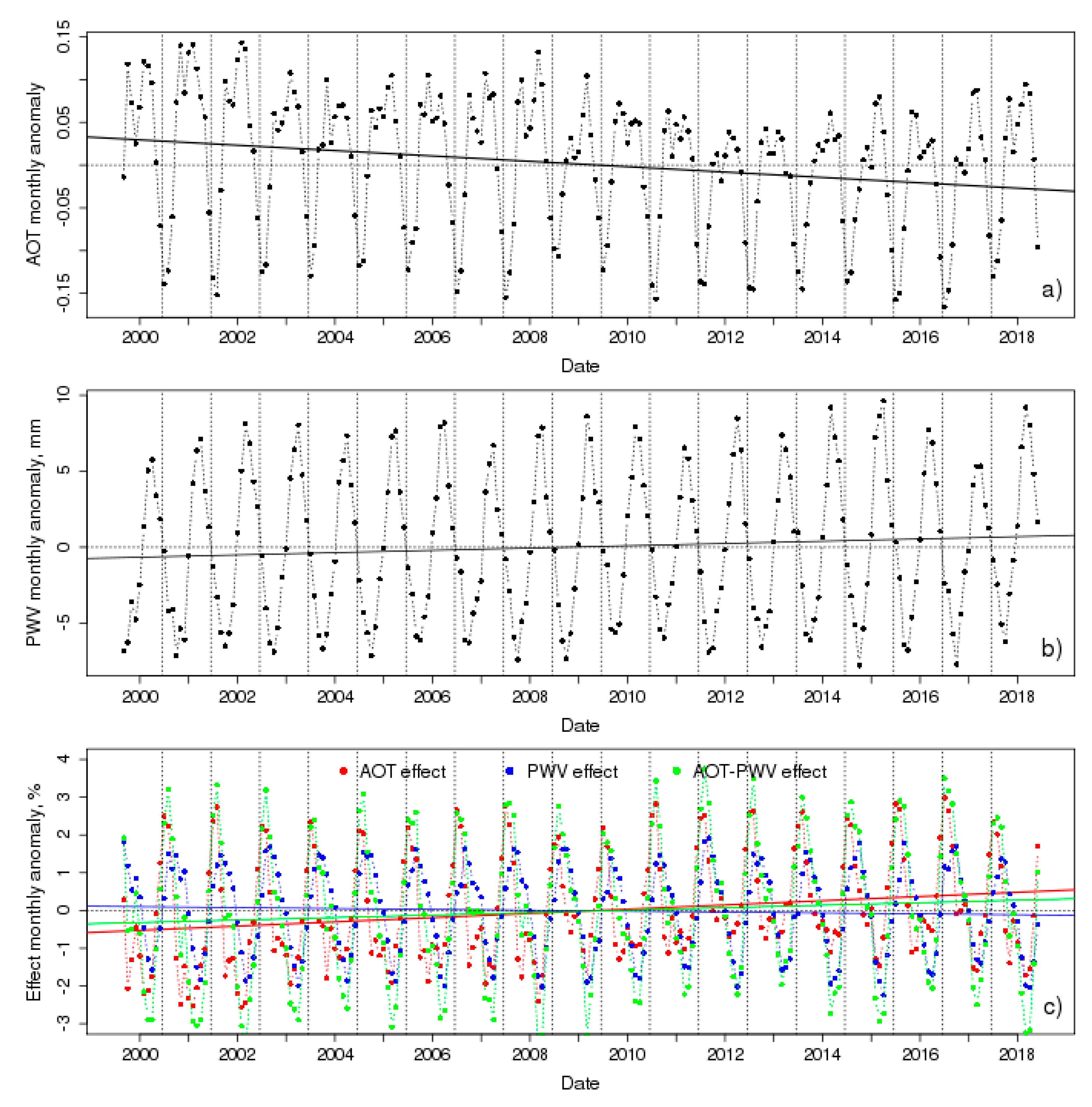

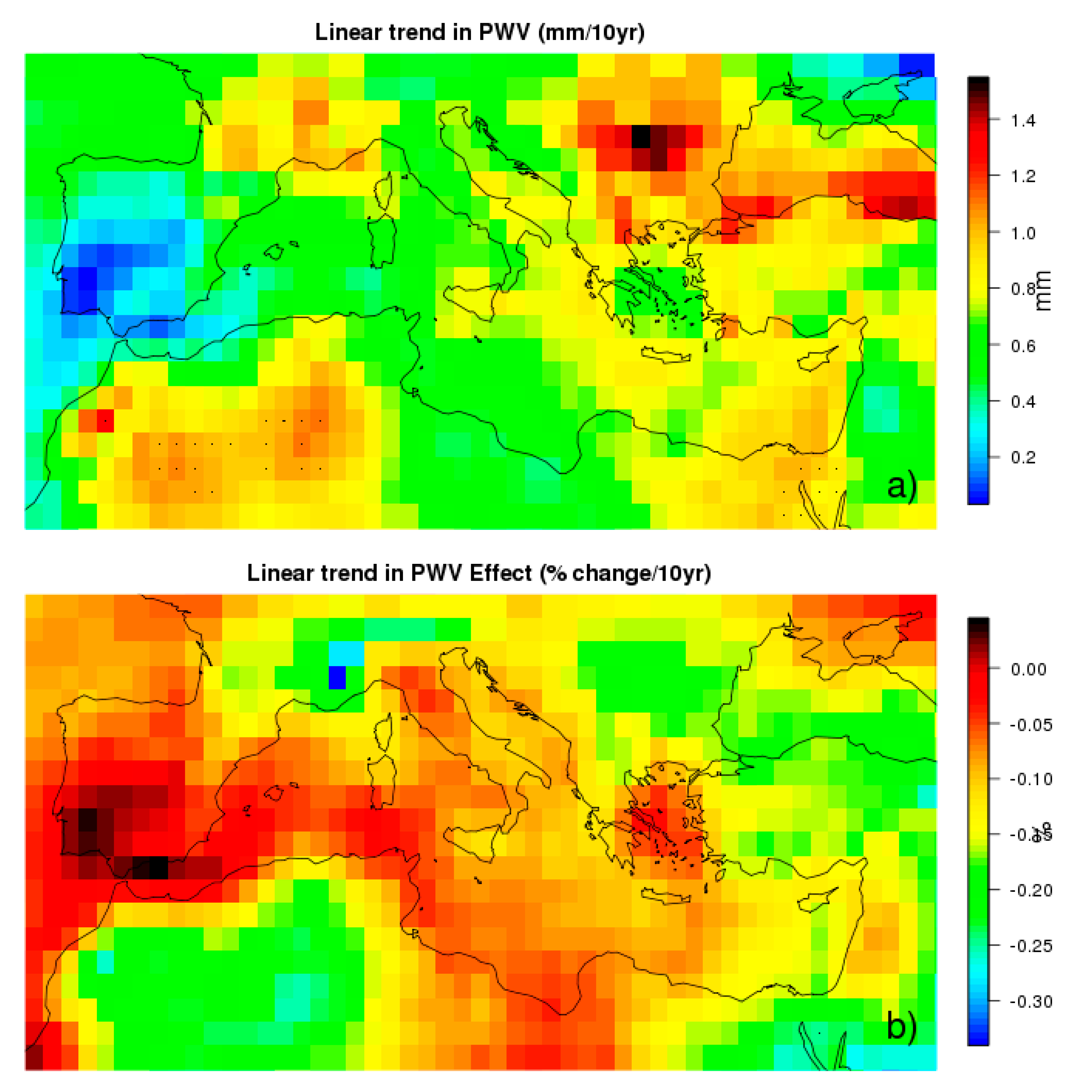
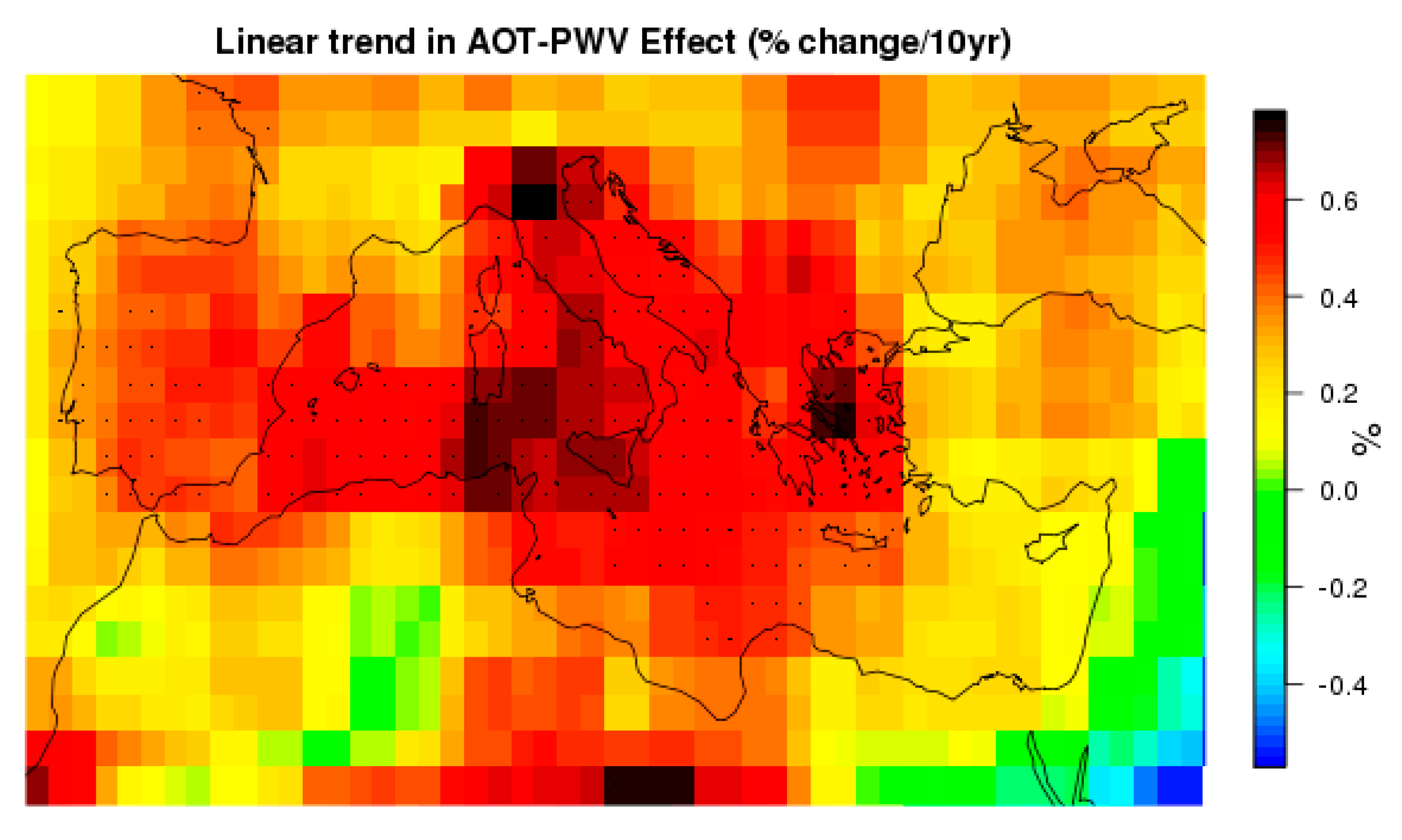
| PWV (mm) AOT | 0 | 6.66 | 13.33 | 20 | 26.66 | 33.33 | 40 | 46.66 | 53.33 | 60 |
|---|---|---|---|---|---|---|---|---|---|---|
| 0 | 0 | 0 | 0 | 0 | 0 | 0 | 0 | 0 | 0 | 0 |
| 0.16 | −2.67 | −2.93 | −2.97 | −2.99 | −3.00 | −2.95 | −2.83 | −2.72 | −2.65 | −2.64 |
| 0.33 | −5.42 | −5.91 | −5.99 | −6.02 | −6.04 | −5.91 | −5.64 | −5.38 | −5.22 | −5.18 |
| 0.50 | −8.15 | −8.84 | −8.94 | −8.99 | −9.00 | −8.78 | −8.31 | −7.89 | −7.67 | −7.65 |
| 0.66 | −10.83 | −11.70 | −11.83 | −11.89 | −11.91 | −11.59 | −10.95 | −10.38 | −10.10 | −10.09 |
| 0.83 | −13.43 | −14.48 | −14.64 | −14.71 | −14.72 | −14.33 | −13.53 | −12.83 | −12.50 | −12.50 |
| 1.00 | −15.96 | −17.17 | −17.35 | −17.43 | −17.44 | −16.98 | −16.04 | −15.22 | −14.86 | −14.86 |
| 1.16 | −18.40 | −19.76 | −19.96 | −20.05 | −20.07 | −19.54 | −18.49 | −17.56 | −17.16 | −17.17 |
| 1.33 | −20.75 | −22.25 | −22.48 | −22.58 | −22.59 | −22.01 | −20.85 | −19.83 | −19.40 | −19.42 |
| 1.5 | −23.02 | −24.65 | −24.89 | −25.00 | −25.02 | −24.40 | −23.15 | −22.05 | −21.58 | −21.60 |
| PWV (mm) AOT | 0 | 6.66 | 13.33 | 20 | 26.66 | 33.33 | 40 | 46.66 | 53.33 | 60 |
|---|---|---|---|---|---|---|---|---|---|---|
| 0 | 0 | −10.25 | −12.48 | −13.96 | −15.10 | −16.04 | −16.85 | −17.56 | −18.20 | −18.78 |
| 0.16 | 0 | −10.49 | −12.75 | −14.25 | −15.40 | −16.29 | −16.99 | −17.61 | −18.18 | −18.75 |
| 0.33 | 0 | −10.71 | −13.00 | −14.51 | −15.66 | −16.48 | −17.04 | −17.53 | −18.02 | −18.58 |
| 0.50 | 0 | −10.92 | −13.24 | −14.75 | −15.89 | −16.62 | −17.00 | −17.33 | −17.77 | −18.33 |
| 0.66 | 0 | −11.12 | −13.47 | −14.99 | −16.13 | −16.76 | −16.96 | −17.15 | −17.53 | −18.11 |
| 0.83 | 0 | −11.33 | −13.70 | −15.23 | −16.37 | −16.91 | −16.94 | −16.98 | −17.32 | −17.90 |
| 1.00 | 0 | −11.53 | −13.93 | −15.47 | −16.60 | −17.06 | −16.93 | −16.83 | −17.12 | −17.71 |
| 1.16 | 0 | −11.74 | −14.16 | −15.71 | −16.84 | −17.22 | −16.94 | −16.71 | −16.95 | −17.55 |
| 1.33 | 0 | −11.94 | −14.38 | −15.94 | −17.07 | −17.38 | −16.95 | −16.60 | −16.80 | −17.41 |
| 1.5 | 0 | −12.14 | −14.61 | −16.18 | −17.31 | −17.55 | −16.98 | −16.52 | −16.66 | −17.28 |
| 0 | 6.66 | 13.33 | 20 | 26.66 | 33.33 | 40 | 46.66 | 53.33 | 60 | |
|---|---|---|---|---|---|---|---|---|---|---|
| 0 | 0 | −10.25 | −12.48 | −13.96 | −15.10 | −16.04 | −16.85 | −17.56 | −18.20 | −18.78 |
| 0.16 | −2.67 | −12.87 | −15.08 | −16.54 | −17.66 | −18.52 | −19.21 | −19.80 | −20.36 | −20.92 |
| 0.33 | −5.42 | −15.55 | −17.72 | −19.15 | −20.23 | −21.01 | −21.54 | −22.00 | −22.46 | −22.99 |
| 0.50 | −8.15 | −18.18 | −20.31 | −21.70 | −22.75 | −23.41 | −23.76 | −24.07 | −24.47 | −24.99 |
| 0.66 | −10.83 | −20.75 | −22.84 | −24.20 | −25.21 | −25.78 | −25.96 | −26.12 | −26.46 | −26.97 |
| 0.83 | −13.43 | −23.24 | −25.29 | −26.62 | −27.60 | −28.07 | −28.10 | −28.13 | −28.43 | −28.93 |
| 1.00 | −15.96 | −25.65 | −27.67 | −28.96 | −29.91 | −30.30 | −30.19 | −30.11 | −30.35 | −30.85 |
| 1.16 | −18.40 | −27.98 | −29.95 | −31.22 | −32.14 | −32.45 | −32.22 | −32.04 | −32.23 | −32.72 |
| 1.33 | −20.75 | −30.22 | −32.15 | −33.39 | −34.28 | −34.53 | −34.19 | −33.91 | −34.07 | −34.55 |
| 1.5 | −23.02 | −32.37 | −34.27 | −35.47 | −36.35 | −36.53 | −36.10 | −35.73 | −35.85 | −36.32 |
© 2020 by the authors. Licensee MDPI, Basel, Switzerland. This article is an open access article distributed under the terms and conditions of the Creative Commons Attribution (CC BY) license (http://creativecommons.org/licenses/by/4.0/).
Share and Cite
Obregón, M.A.; Costa, M.J.; Silva, A.M.; Serrano, A. Spatial and Temporal Variation of Aerosol and Water Vapour Effects on Solar Radiation in the Mediterranean Basin during the Last Two Decades. Remote Sens. 2020, 12, 1316. https://doi.org/10.3390/rs12081316
Obregón MA, Costa MJ, Silva AM, Serrano A. Spatial and Temporal Variation of Aerosol and Water Vapour Effects on Solar Radiation in the Mediterranean Basin during the Last Two Decades. Remote Sensing. 2020; 12(8):1316. https://doi.org/10.3390/rs12081316
Chicago/Turabian StyleObregón, Maria A., Maria João Costa, Ana Maria Silva, and Antonio Serrano. 2020. "Spatial and Temporal Variation of Aerosol and Water Vapour Effects on Solar Radiation in the Mediterranean Basin during the Last Two Decades" Remote Sensing 12, no. 8: 1316. https://doi.org/10.3390/rs12081316
APA StyleObregón, M. A., Costa, M. J., Silva, A. M., & Serrano, A. (2020). Spatial and Temporal Variation of Aerosol and Water Vapour Effects on Solar Radiation in the Mediterranean Basin during the Last Two Decades. Remote Sensing, 12(8), 1316. https://doi.org/10.3390/rs12081316








